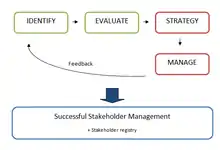
In management, a stakeholder approach is the practice that managers formulate and implement processes that satisfy stakeholders' needs to ensure long-term success.[1] According to the degree of participation of the different groups, the company can take advantage of market imperfections to create valuable opportunities. It emphasizes active management of the business environment, relationships and the promotion of shared interests.[2] This approach is based on stakeholder theory, which arises as a counterpart to business practices and management that focus on shareholders satisfaction.[3] The implementation of this approach can reinforce the firm values and create competitive advantage. However, it has been criticized for overvaluing stakeholders and its difficulty to reach consensus.

Utility
Competitive advantage
This approach may create competitive advantage because it links the firm and stakeholders. The latter perceive the coherent application of the organizational values and relate to those. In that way, the company has the information about stakeholders it needs to treat them well and develop important initiatives. This reinforces the firm's reputation and loyalty among customers and other stakeholders, creates stronger brand recognition and increases trust in the firm. Even if there are limits in loyalty and reputation can be damaged, those two key elements can make a big difference creating barriers to other companies that may want to have information about stakeholder utility functions. Proponents maintain that a firm that follows the stakeholder approach gets the information it needs to satisfy the stakeholders' needs, making it easier to develop expertise. Those acquired skills can be transmitted, promoted and reinforced across the business operation of the firm creating core competencies. Over time, this approach can become an indispensable issue in the organizational culture.[4][5]
Value creating through innovation
Firms that manage for stakeholders are more able to attract a higher-quality workforce. Employees' job satisfaction has an impact on the firm's ability to foster innovation. Workers who are satisfied with their jobs are more likely to engage in long-term thinking and generate potentially valuable ideas. Those firms can use information about stakeholder to devise new ways of satisfying them.[6] Reciprocity is a key aspect in this approach: when stakeholders stand to benefit, they are more likely to reveal information about their utility function. That is why firms and firm managers can better meet consumers' needs by understanding their own customers and suppliers and using this information strategically and flexibly.[5]
Limits
Divergent interests
Trying to satisfy a large number of players complicates governance, and may make it difficult to reach consensus. The consideration of so many varying interests is likely to produce divergent opinions,[7] while individual interests and self-motivated actors may warp decision-making outcomes.[8] Moreover, this approach has been criticized for implying that all stakeholders negotiate on a level playing field, ignoring potential disparities between the various interested parties.[7]
Overvaluing stakeholders
It has been suggested that obtaining information about stakeholders' utility functions may produce costs that can exceed the benefits. Therefore, in its intention to create value, managing for stakeholders can end up allocating too many resources to stakeholders. Further, taking into account that power among stakeholders is not evenly distributed, certain actors may be able to appropriate more of a firm's profit for themselves than other interested parties. This warps the distribution of value between shareholders, rather than maximizing returns.[5]
References
- ↑ Post, James E.; Preston, Lee E.; Sachs, Sybille (2002-10-01). "Managing the Extended Enterprise: The New Stakeholder View". California Management Review. 45 (1): 6–28. doi:10.2307/41166151. ISSN 0008-1256. JSTOR 41166151. S2CID 154482316.
- ↑ Freeman, R. Edward; McVea, John (2001-01-01). "A Stakeholder Approach to Strategic Management". SSRN 263511.
{{cite journal}}: Cite journal requires|journal=(help) - ↑ Freeman, R. Edward; Harrison, Jeffrey S.; Wicks, Andrew C.; Parmar, Bidhan L.; Colle, Simone de (2010-04-01). Stakeholder Theory: The State of the Art. Cambridge University Press. ISBN 9781139484114.
- ↑ Maignan, Isabelle; Gonzalez, Tracy; Hult, Tomas; Ferrell, O.C. (25 July 2011). "Stakeholder orientation: development and testing of a framework for socially responsible marketing". Journal of Strategic Marketing. 19 (4): 313–338. doi:10.1080/0965254x.2011.581384. S2CID 167670320.
- 1 2 3 Harrison, Jeffrey S.; Bosse, Douglas A.; Phillips, Robert A. (2010-01-01). "Managing for Stakeholders, Stakeholder Utility Functions, and Competitive Advantage". Strategic Management Journal. 31 (1): 58–74. doi:10.1002/smj.801. JSTOR 27735509. S2CID 67767689.
- ↑ Flammer, Caroline; Kacperczyk, Aleksandra (2014-08-19). "The Impact of Stakeholder Orientation on Innovation: Evidence from a Natural Experiment". SSRN 2353076.
{{cite journal}}: Cite journal requires|journal=(help) - 1 2 O'Haire, Christen; McPheeters, Melissa; Nakamoto, Erika; LaBrant, Lia; Most, Carole; Lee, Kathy; Graham, Elaine; Cottrell, Erika; Guise, Jeanne-Marie (2011-06-01). Strengths and Limitations of Stakeholder Engagement Methods. Agency for Healthcare Research and Quality (US).
- ↑ "The Risks of Relying on Stakeholder Engagement for the Achievement of Sustainability (PDF Download Available)". ResearchGate. Retrieved 2017-05-06.
External links
- Negotiation power - Program on negotiation. Harvard Law School
- Innovation - Australian government. Department of Industry, Innovation and Science.